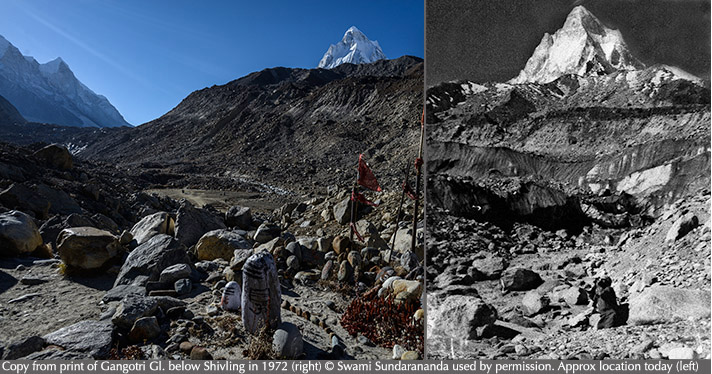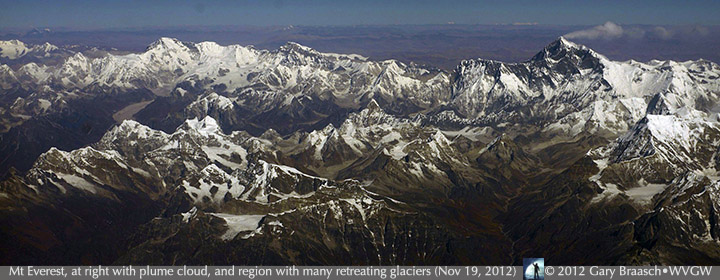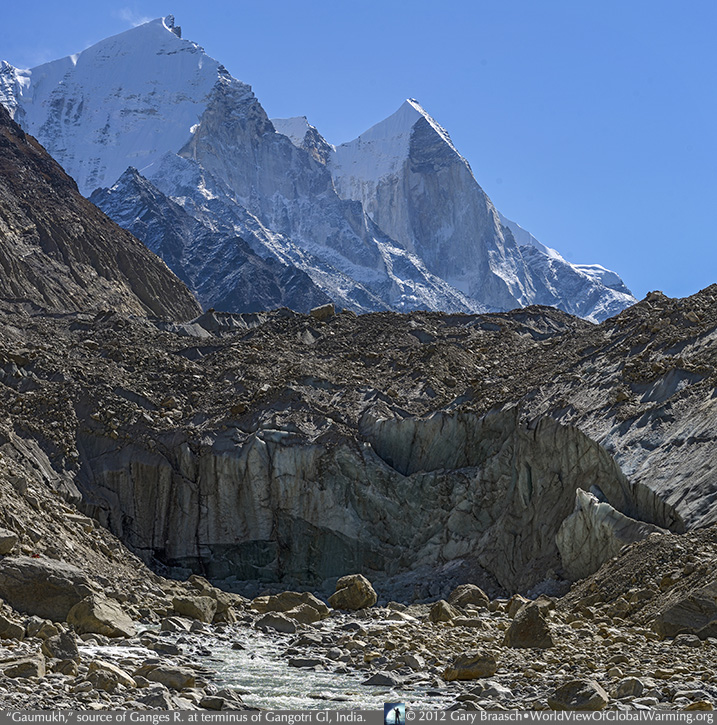Himalaya Glaciers
Retreating glaciers and icecaps, including in the Himalayas, continue to inform climate action, are focus of new scientific and photography studies.
Portfolio of images here.
Melting ice around the world remains in the news and central to the scientific evidence of climate change informing international negotiations at COP18, in Doha. New scientific reports and observations have shown the rapid changes to the polar regions and the mountain sources of so much of the world's fresh water, and how they contribute to sea level rise. One research paper in the journal Science by an international group of 47 scientists assembled 50 different ice-sheet loss estimates over two decades, and showed yearly ice loss from Greenland and Antarctica is now three times the rate of 20 years ago. Another paper, in Environmental Research Letters, compared the 2007 United Nations IPCC sea level rise projections with actual measurements and found that the oceans are rising much more rapidly than the 2007 estimates. Other dedicated photographers with strong scientific backgrounds are also adding to our knowledge of how glaciers are changing, including mountaineer and filmmaker David Breashears (whom we met in Kathmandu), and long-time friend photographer Jim Balog whose film about his glacier time-lapse imagery, "Chasing Ice," has been released.
Next here, reports from Bhutan, whose Gross National Happiness measurements are gaining stature in the United Nations ... while it faces decisions about how to use its abundant rivers and projected water power to serve the people without destroying the ecosystems they depend on.
Shrinking source glacier of the Ganges River -- symbol of climate change for mountains and mountain cultures of the world.
Portfolio of images here.
The sacred Ganges River, essential to northern Indian life and source of much of Hindu religious practice, flows from a broad region in the Indian and Nepal Himalaya. The major stem of "Ganga" is the Bhagirathi River, which emerges as a large mountain stream from beneath the 28.5 km long Gangotri Glacier in the state of Uttarakhand, India, north of New Delhi. The glacier has been retreating for more than a century, recently at slightly more slowly than before, but still at a rate of 18 meters per year.
The Gangotri is the second largest glacier in India, a mountain glacier with six major and many minor tributary glaciers. Some of these side glaciers no longer connect with the central glacier. This source of the Ganges has been a holy place for more than a thousand years, the place where the Goddess Ganga touched down to earth, and thus has been the goal and destination of devout pilgrims and holy men to view and be blessed by the pure glacier water.
The photographs presented here are a preliminary report on our own World View of Global Warming journey to the Gangotri, part of our reports on climate change and water in the Himalayas. More images and information will follow.
At one time, nearly 4,000 years ago, the glacier was about 18 km longer with a terminus at a waterfall over carved granite at what is now Gangotri village. The rock carved by the flow of the river and ice had the appearance of water emerging from a cows mouth -- thus giving it the name Gaumukh in Sanscrit. Through time, as the glacier receded up the valley, the terminus of the glacier featured a cave or arch out of which the river flowed, and Gaumukh has remained the name of the place from which the sacred Ganga emerges from the Himalaya Mountains regardless of its exact position as the glacier has changed. The face of the glacier and river source at about 4000 m are now more than an 18 km hike from Gangotri village, which is at 3000 m elevation. Thousands of pilgrims, the devout, tourists and mountaineers make this journey each year, following the Bhagirathi River.
With studies of Himalaya glaciers increasing as a way to monitor climate change, scientists have also motored the cliff-hanging road to Gangotri and trekked the well-trodden trail to the place where the great Ganges appears from under the ice. Others have measured the glacier changes using satellite pictures and sensors. The infamous mistake in the 2007 United Nations IPCC report, which erroneously claimed Himalayan glaciers would mostly disappear by 2035, and the importance of mountain water to more than a billion people, have brought increased scrutiny to glacier changes and the importance of the meltwater.

The Gangotri's rapid retreat up its valley has concerned devout Hindus as well as scientists for years. As documented in these nearly-matching views, the ice has melted away from sacred shrines and extended the trek to the holy Gaumukh where the river springs from the glacier. Current studies, such as the one entitled " Himalayan glaciers: The big picture is a montage," by scientist Jeffrey Kargel and colleages, find that "although it will not disappear anytime soon, [Gangotri Glacier] and probably most other large Himalayan glaciers will likely shrink dramatically this century" with thinning of debris covered tongues and growth of moraine-blocked lakes. This study, published in 2011, agrees with satellite image measurements and Indian Government studies that the rapid retreat of the Gangotri of about a mile in the 20th C has slowed recently, but says that is probably due to very heavy debris and dirt cover on the glacier. Satellite measurements by Jennifer Ding show an average retreat of about 18 m per year from 1990 to 2009. Across the Indian Himalaya, satellite measurements show that 2184 glaciers of a total of 2767 are retreating, 435 advancing, and 148 show little change.
Slowing of retreat does not mean the glacier is stabilizing nor does it prove that global warming is is tapering off. The Kargel study says that "many debris-laden glaciers are thinning in place without much terminus retreat." The lower Gangotri appears to have thinned by about 5 meters in as many recent years. Indian government studies also say that snow cover in the glacier basin has been diminishing since the 1980s, which means that less snow is feeding the river. This may be an effect of rising temperatures and effects of climate change on monsoons and storms. But the 2500 mile long Ganges is not dependent on snow or glacier flow for most of its water, according to scientists like Kargel and his Indian colleagues. After the Ganga proper is formed at the confluence of the Bhagirathi and the Alaknanda Rivers, less than 30 percent of the water is from glaciers. The rest is from rainwater and groundwater -- which of course are also under great threat from climate changes as well as intense population pressure and staggering pollution.
During our visit to Gangotri, we were privileged and honored to meet Swami Sundarananda, the 86 year old sadhu, mountaineer, photographer and environmental leader. He has been photographing the Himalaya and the source of the Ganges since the 1950s with great skill and perception. He graciously has allowed us to publish here a copy of one of his prints of the glacier from 1972 to help show changes over 40 years. The Swami's intense emotions about and knowledge of the destructive growth of development in the Himalaya are a model of environmental communication.
More comparison photography, with the cooperation of Swami Sundarananda, scientists and others will be featured later on this website.
Swami Sundarananda's great book "Himalaya: Through the Lens of a Sadhu" can be ordered from the author at: Tapovan Kuti, Gangotri, District Uttarkashi - 249 193, Uttarakhand, India. Telephone (91) 013 772 22 31. Or order from the distributor: Systems Vision, A-199, Okhla Phase-1, New Delhi 110 020, India. Telephone (91) 681 1195, fax (91) 681 2018, e-mail: svision@vsnl.com .
Funding for our Himalaya reporting is graciously provided by the Karuna Foundation - US, and other generous donors.
This project would be impossible without scientists and observers around the world who have provided hundreds of scientific contacts and papers. See Background, Advisors, and Reference for documentation, funders and major advisors, without whom I could not complete the work.
World View of Global Warming is a project of the Blue Earth Alliance, Seattle Washington, a 501(c)3 tax-exempt organization. The project is supported entirely by donations, grants, and license fees for the photographs. Please see information about how to contribute.
For other information about Gary Braasch's climate change projects and books, please see the books Earth Under Fire and How We Know What We Know About Our Changing Climate, and the exhibit "Climate Change in Our World" at the Books and Exhibits link.
Please see other Himalaya stories in the Climate Changes menu above.
OR
Water | Landslide | Cookstoves | Ganges Glaciers | Bhutan
COPYRIGHT NOTICE:
Photography and text Copyright © 2005 - 2017 (and before) Gary Braasch All rights reserved. Use of photographs in any manner without permission is prohibited by US copyright law. Photography is available for license to publications and other uses. Please contact requestinformation@worldviewofglobalwarming.org. View more of Gary Braasch's photography here.




